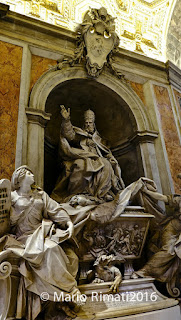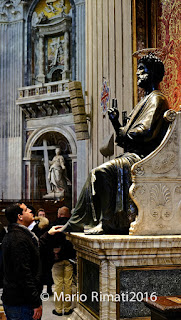After having read the recent
great book by Italian author, Alberto Angela, on the secrets and marvels of St.
Peter’s Basilica in these last 2,000 years, I thought I’d spend a morning inside the world’s most famous Basilica (and with right in front
one of the world’s most famous squares too).
The last time I had
been inside the Basilica was close to three years ago during the celebrations for
the election of Pope Francis (I had worked during that Conclave for NBC news). And
speaking of the Argentine pope, on more than one occasion he’s said that he wants a “poor church”!
Really?
You can see for yourself just
what’s inside the Basilica, including works of two truly amazing artists, Gian
Lorenzo Bernini and Michelangelo, who (the latter that is) at the tender age of 23 sculpted what’s
perhaps THE world’s greatest sculpture, “La Pieta’”! And what price can we possibly put on that
amazing work of art, not to mention on Bernini’s bronze columns or the square he had designed which was shaped as an immense "embrace", the embrace of humanity itself?
Inside the basilica: St. Peter's 187 meters long, the cupola stretches up to the sky 133 meters and the entire area covers 22,000 sq. meters, about the size of three soccer pitches. Of these 22,000 meters, 16,000 are covered with fine marble stone. The mosaics instead cover a "mere" 10,000 meters. The basilica can also hold up to 60,000 visitors at a time.
Inside the basilica: St. Peter's 187 meters long, the cupola stretches up to the sky 133 meters and the entire area covers 22,000 sq. meters, about the size of three soccer pitches. Of these 22,000 meters, 16,000 are covered with fine marble stone. The mosaics instead cover a "mere" 10,000 meters. The basilica can also hold up to 60,000 visitors at a time.
(The pope's Swiss Guards standing on guard)
(The facade of St. Peter's Basilica which was designed by Carlo Maderno)
(The five-meter tall statue of St. Paul in front of St. Peter's Basilica)
(The Basilica's Holy Door which was opened by Pope Francis on December 8th, 2015)
(Details of the Holy Door)
(The monument by Antonio Canova in honor of the Stuart family )
(Bernini's monument to Matilda di Canossa. Henry IV is kneeling, on the bottom, at the feet of Pope Gregorius VII)
(The two-meter tall statue of St. Peter. His right foot is worn out as pilgrims touch and kiss it in a sign of reverence)
(Bernini's famous and amazing altar and 4 supporting bronze columns. It's 29 meters tall, about the height of a 10-story building, and weighs a "mere" 63 tons! The so-called small "putti" located on top are 2.5 meters tall. Bernini completed the altar in 1627. He was only 25 years old)

(The 99 candles that adorn the tomb area of St. Peter)
(Details of Bernini's bronze columns)
column
(The small "putti" are 2.5 meters tall)
(Just some of the VERY fine marble around the entire basilica)
(Michelangelo's cupola. As he was hanging up there working on the cupola he nearly fell off the scaffolding and almost fell to the ground. Because of the scare his beard turned white, so they say. Quite the amazing example of engineering if you think that the cupola weighs 14,000 tons and is 133 meters tall!)
(Bernini's monument to Pope Alexander VII)
(Perhaps the world's greatest sculpture considering that the man who created it, Michelangelo, was only 23 at the time?)
(The legend says that at the time someone was going around Rome boasting that HE was Michelangelo who had come up with "La Pieta'". Somewhat outraged, when the real one found out he signed his name across Mary's sash. It's apparently the only work of art which was signed by (the real) Michelangelo)
(One of the basilica's doors with the image of St. Peter who has been crucified with his head handing down)
(The pope's personal Swiss Guards, the world's smallest army, and some believe the oldest too. Michelangelo designed their uniforms, even though some suspect that piece of information isn't completely true)
(The five-meter tall statue of St. Peter and his famous keys in front of St. Peter's Basilica. The top of the facade is adorned with 13 statues: Jesus, St. John the Baptist and 11 Apostles)
(The facade's main "Loggia of the Benedictions" from where the pope greets the crowds, especially during the yearly "Urbi et Orbi", to Rome and to the World speech)
(Two large clocks are located on both sides of the facade. They're 4 meters tall and were designed by Giuseppe Valadier. Two bell towers had originally been there. They had been created by Bernini but they crumbled to the ground, and so they were therefore replaced by the 2 lighter clocks)
(Vatican and Italian police on guard for Pope Francis)
(The central obelisk is the city's second tallest at 25 meters. It's originally from Egypt. It had been brought to Rome by the Emperor Caracalla in 37 A.D. Rome is the city with the highest number of obelisks in the entire world as the ancient Romans were fascinated by them)



























































































No comments:
Post a Comment